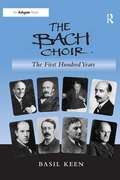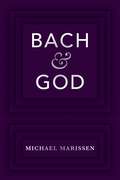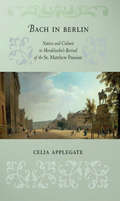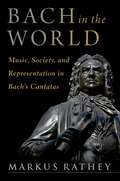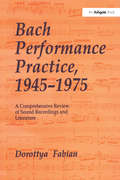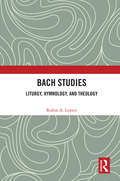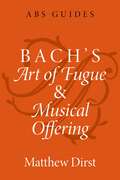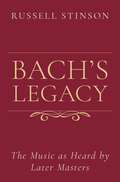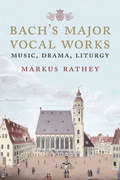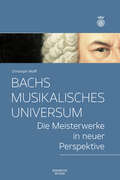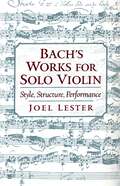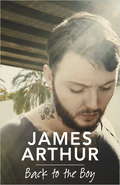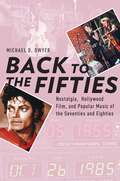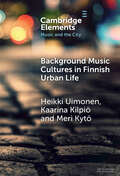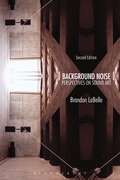- Table View
- List View
The Bach Choir: The First Hundred Years
by Basil KeenThis study of the Bach Choir provides a much-needed overview of one of the major choral societies in London. Dr Basil Keen examines the background that led to the formation of an ad hoc body to give the first performance in England of J.S. Bach's B minor Mass. The musical and organizational effects of a permanent choral society drawn from one social group are traced during the first twenty years, after such time the pressures of social change led to a complete review followed by a restructuring of the methods of recruitment and internal organization. The rebuilding of the choir at the opening of the twentieth century, the expansion of the repertoire, the upheaval resulting from the First World War and the impact of these events on preparation and performance, are all considered. The book is essentially structured around the tenure of successive Musical Directors: Otto Goldschmidt, Charles Villiers Stanford, Walford Davies, Hugh Allen, Ralph Vaughan Williams, Adrian Boult, Reginald Jacques and David Willcocks, since their varied tastes and interests inevitably had a decisive influence on policy. Keen draws upon previously unpublished material, including minutes and correspondence of the Bach Choir, interviews with relatives and descendants, and examination of family records and correspondence. To date, there has been no survey of a major London choir that encompasses the full history of the organization in context. In this study, Dr Basil Keen provides a thorough examination of the Bach Choir, including the response of the choir to social changes; the influence of conductors and officials; changes in musical taste; relationships with composers and composition; major national and international events; and the effect of these matters on organization and repertoire.
Bach & God
by Michael MarissenBach & God explores the religious character of Bach's vocal and instrumental music in seven interrelated essays. Noted musicologist Michael Marissen offers wide-ranging interpretive insights from careful biblical and theological scrutiny of the librettos. Yet he also shows how Bach's pitches, rhythms, and tone colors can make contributions to a work's plausible meanings that go beyond setting texts in an aesthetically satisfying manner. In some of Bach's vocal repertory, the music puts a "spin" on the words in a way that turns out to be explainable as orthodox Lutheran in its orientation. In a few of Bach's vocal works, his otherwise puzzlingly fierce musical settings serve to underscore now unrecognized or unacknowledged verbal polemics, most unsettlingly so in the case of his church cantatas that express contempt for Jews and Judaism. Finally, even Bach's secular instrumental music, particularly the late collections of "abstract" learned counterpoint, can powerfully project certain elements of traditional Lutheran theology. Bach's music is inexhaustible, and Bach & God suggests that through close contextual study there is always more to discover and learn.
Bach & God
by Michael MarissenBach & God explores the religious character of Bach's vocal and instrumental music in seven interrelated essays. Noted musicologist Michael Marissen offers wide-ranging interpretive insights from careful biblical and theological scrutiny of the librettos. Yet he also shows how Bach's pitches, rhythms, and tone colors can make contributions to a work's plausible meanings that go beyond setting texts in an aesthetically satisfying manner. In some of Bach's vocal repertory, the music puts a "spin" on the words in a way that turns out to be explainable as orthodox Lutheran in its orientation. In a few of Bach's vocal works, his otherwise puzzlingly fierce musical settings serve to underscore now unrecognized or unacknowledged verbal polemics, most unsettlingly so in the case of his church cantatas that express contempt for Jews and Judaism. Finally, even Bach's secular instrumental music, particularly the late collections of "abstract" learned counterpoint, can powerfully project certain elements of traditional Lutheran theology. Bach's music is inexhaustible, and Bach & God suggests that through close contextual study there is always more to discover and learn.
Bach in Berlin: Nation and Culture in Mendelssohn's Revival of the "St. Matthew Passion"
by Celia ApplegateBach's St. Matthew Passion is universally acknowledged to be one of the world's supreme musical masterpieces, yet in the years after Bach's death it was forgotten by all but a small number of his pupils and admirers. The public rediscovered it in 1829, when Felix Mendelssohn conducted the work before a glittering audience of Berlin artists and intellectuals, Prussian royals, and civic notables. The concert soon became the stuff of legend, sparking a revival of interest in and performance of Bach that has continued to this day. Mendelssohn's performance gave rise to the notion that recovering and performing Bach's music was somehow "national work." In 1865 Wagner would claim that Bach embodied "the history of the German spirit's inmost life." That the man most responsible for the revival of a masterwork of German Protestant culture was himself a converted Jew struck contemporaries as less remarkable than it does us today—a statement that embraces both the great achievements and the disasters of 150 years of German history. In this book, Celia Applegate asks why this particular performance crystallized the hitherto inchoate notion that music was central to Germans' collective identity. She begins with a wonderfully readable reconstruction of the performance itself and then moves back in time to pull apart the various cultural strands that would come together that afternoon in the Singakademie. The author investigates the role played by intellectuals, journalists, and amateur musicians (she is one herself) in developing the notion that Germans were "the people of music." Applegate assesses the impact on music's cultural place of the renewal of German Protestantism, historicism, the mania for collecting and restoring, and romanticism. In her conclusion, she looks at the subsequent careers of her protagonists and the lasting reverberations of the 1829 performance itself.
Bach in the World: Music, Society, and Representation in Bach's Cantatas
by Markus RatheyJohann Sebastian Bach's works are often classified as either sacred or secular. While this distinction is fraught, it seems to provide a useful way to distinguish between Bach's vocal works for the liturgy and those he wrote to honor courts and members of the nobility. But even so, the lines cannot be drawn clearly. The political and social systems of the time relied on religion as an ideological foundation, and public displays of political power almost always included religious rituals and thus required some form of sacred music. Social constructs, such as class and gender, were also embedded in religious frameworks. In Bach in the World, author Markus Rathey offers a new exploration of how Bach's music functioned as an agent of affective communication within rituals, such as the installation of the town council, and as a place where socio-political norms were perpetuated and sometimes even challenged. The book does so by analyzing public manifestations of the social order during Bach's time in large-scale celebrations, processions, public performances, and visual displays.
Bach in the World: Music, Society, and Representation in Bach's Cantatas
by Markus RatheyJohann Sebastian Bach's works are often classified as either sacred or secular. While this distinction is fraught, it seems to provide a useful way to distinguish between Bach's vocal works for the liturgy and those he wrote to honor courts and members of the nobility. But even so, the lines cannot be drawn clearly. The political and social systems of the time relied on religion as an ideological foundation, and public displays of political power almost always included religious rituals and thus required some form of sacred music. Social constructs, such as class and gender, were also embedded in religious frameworks. In Bach in the World, author Markus Rathey offers a new exploration of how Bach's music functioned as an agent of affective communication within rituals, such as the installation of the town council, and as a place where socio-political norms were perpetuated and sometimes even challenged. The book does so by analyzing public manifestations of the social order during Bach's time in large-scale celebrations, processions, public performances, and visual displays.
Bach Performance Practice, 1945-1975: A Comprehensive Review of Sound Recordings and Literature
by Dorottya FabianAnalysing over 100 recordings from 1945-1975, this book examines twentieth-century baroque performance practice as evinced in all the commercially available recordings of J.S. Bach's Passions, Brandenburg Concertos and Goldberg Variations. Dorottya Fabian presents a qualitative, style-orientated history of the early music movement in its formative years through a comparison of the performance style heard in these recordings with the scholarly literature on Bach performance practice. Issues explored in the book include the availability of resources, balance, tempo, dynamics, ornamentation, rhythm and articulation. During the decades following the Second World War, the early music movement was more concerned with the revival of repertoire than with the revival of performance style which meant that its characteristics and achievements differed essentially from those of the later 1970s and 1980s. Period practice techniques were not practised even by ensembles using eighteenth-century instruments. Yet, as this survey reveals, several recordings of the period provide unexpectedly stylish interpretations using metre and pulse to punctuate the music. Such metric performance and appropriate articulation helped to clarify structure and texture and assisted in the creation of a musical discourse - the pre-eminent goal of baroque compositions.
Bach Performance Practice, 1945-1975: A Comprehensive Review of Sound Recordings and Literature
by Dorottya FabianAnalysing over 100 recordings from 1945-1975, this book examines twentieth-century baroque performance practice as evinced in all the commercially available recordings of J.S. Bach's Passions, Brandenburg Concertos and Goldberg Variations. Dorottya Fabian presents a qualitative, style-orientated history of the early music movement in its formative years through a comparison of the performance style heard in these recordings with the scholarly literature on Bach performance practice. Issues explored in the book include the availability of resources, balance, tempo, dynamics, ornamentation, rhythm and articulation. During the decades following the Second World War, the early music movement was more concerned with the revival of repertoire than with the revival of performance style which meant that its characteristics and achievements differed essentially from those of the later 1970s and 1980s. Period practice techniques were not practised even by ensembles using eighteenth-century instruments. Yet, as this survey reveals, several recordings of the period provide unexpectedly stylish interpretations using metre and pulse to punctuate the music. Such metric performance and appropriate articulation helped to clarify structure and texture and assisted in the creation of a musical discourse - the pre-eminent goal of baroque compositions.
Bach Studies: Liturgy, Hymnology, and Theology
by Robin A. LeaverThis volume draws together a collection of Robin A. Leaver’s essays on Bach’s sacred music, exploring the religious aspects of this repertoire through consideration of three core themes: liturgy, hymnology, and theology. Rooted in a rich understanding of the historical sources, the book illuminates the varied ways in which Bach’s sacred music was informed and shaped by the religious, ritual, and intellectual contexts of his time, placing these works in the wider history of Protestant church music during the Baroque era. Including research from across a span of forty years, the chapters in this volume have been significantly revised and expanded for this publication, with several pieces appearing in English for the first time. Together, they offer an essential compendium of the work of a leading scholar of theological Bach studies.
Bach Studies: Liturgy, Hymnology, and Theology (Contextual Bach Studies #3)
by Robin A. LeaverThis volume draws together a collection of Robin A. Leaver’s essays on Bach’s sacred music, exploring the religious aspects of this repertoire through consideration of three core themes: liturgy, hymnology, and theology. Rooted in a rich understanding of the historical sources, the book illuminates the varied ways in which Bach’s sacred music was informed and shaped by the religious, ritual, and intellectual contexts of his time, placing these works in the wider history of Protestant church music during the Baroque era. Including research from across a span of forty years, the chapters in this volume have been significantly revised and expanded for this publication, with several pieces appearing in English for the first time. Together, they offer an essential compendium of the work of a leading scholar of theological Bach studies.
Bach's Art of Fugue and Musical Offering (The ABS Guides Series)
by Matthew DirstThe initial volume in a series of American Bach Society Guides, Bach's Art of Fugue and Musical Offering is a comprehensive study of two closely related masterworks of the late Baroque fugal style. This compact guide, intended for practitioners, music scholars, and a general readership, summarizes a considerable body of knowledge about these famously cerebral collections in an engaging and accessible style. Bach specialist and keyboard player Matthew Dirst explains the Art of Fugue and Musical Offering's idiosyncratic musical language while reviewing how both projects took shape during Bach's final decade. They reflect Bach's lifelong fascination with learned counterpoint, as demonstrated in elaborate series of fugues and canons in both and in an unusually intricate trio sonata in the latter. Dirst provides commentary on individual movements and groups of pieces and on the historical reception of this music, including its impact on other disciplines. Recurring themes include Bach's diligent exploration of contrapuntal types and techniques, his embrace of musical games, and his creative assimilation of diverse musical styles.
Bach's Art of Fugue and Musical Offering (The ABS Guides Series)
by Matthew DirstThe initial volume in a series of American Bach Society Guides, Bach's Art of Fugue and Musical Offering is a comprehensive study of two closely related masterworks of the late Baroque fugal style. This compact guide, intended for practitioners, music scholars, and a general readership, summarizes a considerable body of knowledge about these famously cerebral collections in an engaging and accessible style. Bach specialist and keyboard player Matthew Dirst explains the Art of Fugue and Musical Offering's idiosyncratic musical language while reviewing how both projects took shape during Bach's final decade. They reflect Bach's lifelong fascination with learned counterpoint, as demonstrated in elaborate series of fugues and canons in both and in an unusually intricate trio sonata in the latter. Dirst provides commentary on individual movements and groups of pieces and on the historical reception of this music, including its impact on other disciplines. Recurring themes include Bach's diligent exploration of contrapuntal types and techniques, his embrace of musical games, and his creative assimilation of diverse musical styles.
Bachs Chor. Zum neuen Verständnis
by Rudolf Bossard Andrew ParrottAndrew Parrotts Buch ist das wohl abschließende Wort zu der in der Bachforschung heftig umstrittenen Frage der Besetzung des Chores - eine Streitschrift, die jeder kennen muss, der sich mit der Aufführungspraxis von Bachs Vokalwerken beschäftigt.
Bach's Legacy: The Music as Heard by Later Masters
by Russell StinsonJohann Sebastian Bach's legacy is undeniably one of the richest in the history of music, with a vast influence on posterity that has only grown since his rediscovery in the early nineteenth century. In this latest addition to his long list of Bach studies, renowned Bach scholar Russell Stinson examines how four of the greatest composers of the nineteenth and twentieth centuries - Felix Mendelssohn, Robert Schumann, Richard Wagner, and Edward Elgar - engaged with Bach's legacy, not only as composers per se, but also as performers, conductors, scholars, critics, and all-around musical ambassadors. Detailed analyses of both musical and epistolary sources shed light on how these later masters heard and received Bach's music within their musical circles, while colorful anecdotes about their Bach reception help humanize them, reconstructing the intimate social circumstances in which they performed and discussed Bach's music. Stinson focuses on Mendelssohn's and Schumann's reception of Bach's organ works, Schumann's encounter with the St. Matthew and St. John Passions, Wagner's musings on the Well-Tempered Clavier, and Elgar's (resoundingly negative) thoughts on Bach as a vocal composer. Engagingly written, copiously annotated, and thoroughly up to date, Bach's Legacy traces the historical afterlife of Bach's music and offers fascinating insights into how these later masters defined it for their audiences and beyond.
Bach's Legacy: The Music as Heard by Later Masters
by Russell StinsonJohann Sebastian Bach's legacy is undeniably one of the richest in the history of music, with a vast influence on posterity that has only grown since his rediscovery in the early nineteenth century. In this latest addition to his long list of Bach studies, renowned Bach scholar Russell Stinson examines how four of the greatest composers of the nineteenth and twentieth centuries - Felix Mendelssohn, Robert Schumann, Richard Wagner, and Edward Elgar - engaged with Bach's legacy, not only as composers per se, but also as performers, conductors, scholars, critics, and all-around musical ambassadors. Detailed analyses of both musical and epistolary sources shed light on how these later masters heard and received Bach's music within their musical circles, while colorful anecdotes about their Bach reception help humanize them, reconstructing the intimate social circumstances in which they performed and discussed Bach's music. Stinson focuses on Mendelssohn's and Schumann's reception of Bach's organ works, Schumann's encounter with the St. Matthew and St. John Passions, Wagner's musings on the Well-Tempered Clavier, and Elgar's (resoundingly negative) thoughts on Bach as a vocal composer. Engagingly written, copiously annotated, and thoroughly up to date, Bach's Legacy traces the historical afterlife of Bach's music and offers fascinating insights into how these later masters defined it for their audiences and beyond.
Bach's Major Vocal Works: Music, Drama, Liturgy
by Markus RatheyEvery year, Johann Sebastian Bach’s major vocal works are performed to mark liturgical milestones in the Christian calendar. Written by a renowned Bach scholar, this concise and accessible book provides an introduction to the music and cultural contexts of the composer’s most beloved masterpieces, including the Magnificat, Christmas Oratorio, and St. John Passion. In addition to providing historical information, each chapter highlights significant aspects—such as the theology of love—of a particular piece. This penetrating volume is the first to treat the vocal works as a whole, showing how the compositions were embedded in their original performative context within the liturgy as well as discussing Bach’s musical style, from the detailed level of individual movements to the overarching aspects of each work. Published in the approach to Easter when many of these vocal works are performed, this outstanding volume will appeal to casual concertgoers and scholars alike.
Bachs musikalisches Universum: Die Meisterwerke in neuer Perspektive
by Christoph WolffWas bleibt? Johann Sebastian Bach gestaltete und verfeinerte sein reiches musikalisches Erbe sehr bewusst: Über Jahrzehnte hinweg trug er sorgfältig angelegte Sammlungen, Originaldrucke und reinschriftliche Partituren zusammen, mit denen er Maßstäbe setzen und der Nachwelt im Gedächtnis bleiben wollte – wie eine musikalische Autobiografie. Christoph Wolff porträtiert in seinem neuen Buch anhand dieser Referenzwerke Bachs bahnbrechende künstlerische Leistungen quer durch die verschiedenen Gattungen der Instrumental- und Vokalmusik: Präludien, Fugen und Orgelchoräle, Suiten, Sonaten und Konzerte sowie Kantaten, Passionen, Oratorien und Messen. Auf dieser imponierenden Strecke trieb Bach mit seiner musikalischen Logik und ausdrucksvollen Tonsprache die Kompositionsgeschichte voran.
Bach's Works for Solo Violin: Style, Structure, Performance
by Joel LesterJ. S. Bach's sonatas and partitas for solo violin have been central to the violin repertoire since the mid-eighteenth century. This engaging volume is the first comprehensive exploration of the place of these works within Bach's music: it focuses on their structural and stylistic features as they have been perceived since their creation. Joel Lester, a highly regarded scholar, teacher, violinist, and administrator, combines an analytical study, a full historical guide, and an insightful introduction to Bach's style. Individual movements are related to comparable movements by Bach in other media and are differentiated from superficially similar works from later eras. Lester employs descriptions of historical and contemporary recordings, as well as accounts of nineteenth-century performances and commentaries on historical editions, to explore these works as they evolved through the centuries. Wherever possible, he uses analytic tools culled from eighteenth-century ideas, key notions originally developed for the specific purpose of describing the repertoire under consideration. Beginning with an overview of the solo violin music's place within Bach's oeuvre, this study takes the Sonata No. 1 in G minor as the paradigm of Bach's compositional strategy, examining each movement in detail before enlarging the discussion to cover parallel and contrasting features of the A-minor and C-minor sonatas. Next, a chapter is devoted to the three partitas and their roots in various dance-music traditions. The book concludes with a summary of form, style, and rhetoric in Bach's music, in which Lester muses on these masterpieces with an overall command of the music, criticism, and history of the 1700s that is quite rare among scholars. A novel and unprecedented investigation of a particular portion of Bach's accomplishment and a particular aspect of his universal appeal, Bach's Works for Solo Violin will help violinists, students, scholars, and other listeners develop a deeper personal involvement with these wonderful pieces.
Bach's Works for Solo Violin: Style, Structure, Performance
by Joel LesterJ. S. Bach's sonatas and partitas for solo violin have been central to the violin repertoire since the mid-eighteenth century. This engaging volume is the first comprehensive exploration of the place of these works within Bach's music: it focuses on their structural and stylistic features as they have been perceived since their creation. Joel Lester, a highly regarded scholar, teacher, violinist, and administrator, combines an analytical study, a full historical guide, and an insightful introduction to Bach's style. Individual movements are related to comparable movements by Bach in other media and are differentiated from superficially similar works from later eras. Lester employs descriptions of historical and contemporary recordings, as well as accounts of nineteenth-century performances and commentaries on historical editions, to explore these works as they evolved through the centuries. Wherever possible, he uses analytic tools culled from eighteenth-century ideas, key notions originally developed for the specific purpose of describing the repertoire under consideration. Beginning with an overview of the solo violin music's place within Bach's oeuvre, this study takes the Sonata No. 1 in G minor as the paradigm of Bach's compositional strategy, examining each movement in detail before enlarging the discussion to cover parallel and contrasting features of the A-minor and C-minor sonatas. Next, a chapter is devoted to the three partitas and their roots in various dance-music traditions. The book concludes with a summary of form, style, and rhetoric in Bach's music, in which Lester muses on these masterpieces with an overall command of the music, criticism, and history of the 1700s that is quite rare among scholars. A novel and unprecedented investigation of a particular portion of Bach's accomplishment and a particular aspect of his universal appeal, Bach's Works for Solo Violin will help violinists, students, scholars, and other listeners develop a deeper personal involvement with these wonderful pieces.
Back to the Boy
by James Arthur'The thought behind this book is not just me wanting to tell my story in the standard autobiographical fashion but to create a kind of self-help book that includes my story. There are many things people don't know about me and maybe when they read about those things they will have an understanding of the journey I have been on, why I've made the mistakes I have and hopefully help other people overcome their adversities.'Life has presented its fair share of setbacks for James Arthur, from his disrupted childhood - during which he felt like a stray and a misfit, entering the care system in his teens - to a very public fall from favour just at the point when all his dreams should have been coming true. With an extraordinary comeback in 2016, starting with No. 1 single 'Say You Won't Let Go' and his Platinum album Back From The Edge, Back To The Boy shows the British singer and songwriter reflecting not only on his past but also on his return to the charts, and the phenomenal global success that followed. James shares his struggles with mental health issues which led to drug abuse, and how he dealt with the feelings of intense pressure and loneliness that accompanied his sudden rise to fame. Back to the Boy gives an insight into the life of one of the most exciting musicians of today, and how his experiences are reflected in the raw emotion and passion in his music. This is a story of hope and self-discovery to inspire those who have ever hit rock-bottom and managed to pick themselves up again.
Back to the Fifties: Nostalgia, Hollywood Film, and Popular Music of the Seventies and Eighties (Oxford Music / Media)
by Michael D. DwyerThroughout the 1970s and 1980s, Hollywood studios and record companies churned out films, albums, music videos and promotional materials that sought to recapture, revise, and re-imagine the 1950s. Breaking from dominant wisdom that casts the trend as wholly defined by Ronald Reagan's politics or the rise of postmodernism, Back to the Fifties reveals how Fifties nostalgia from 1973 to 1988 was utilized by a range of audiences for diverse and often competing agendas. Films from American Graffiti to Hairspray and popular music from Sha Na Na to Michael Jackson shaped - and were shaped by - the complex social, political and cultural conditions of the Reagan Era. By closely examining the ways that "the Fifties" was remade and recalled, Back to the Fifties explores how cultural memories were fostered for a generation of teenagers trained by popular culture to rewind, record, recycle and replay.
BACK TO THE FIFTIES OMMS C: Nostalgia, Hollywood Film, and Popular Music of the Seventies and Eighties (Oxford Music / Media)
by Michael D. DwyerThroughout the 1970s and 1980s, Hollywood studios and record companies churned out films, albums, music videos and promotional materials that sought to recapture, revise, and re-imagine the 1950s. Breaking from dominant wisdom that casts the trend as wholly defined by Ronald Reagan's politics or the rise of postmodernism, Back to the Fifties reveals how Fifties nostalgia from 1973 to 1988 was utilized by a range of audiences for diverse and often competing agendas. Films from American Graffiti to Hairspray and popular music from Sha Na Na to Michael Jackson shaped - and were shaped by - the complex social, political and cultural conditions of the Reagan Era. By closely examining the ways that "the Fifties" was remade and recalled, Back to the Fifties explores how cultural memories were fostered for a generation of teenagers trained by popular culture to rewind, record, recycle and replay.
Background Music Cultures in Finnish Urban Life (Elements in Music and the City)
by null Heikki Uimonen null Kaarina Kilpiö null Meri KytöThis Element focuses on how music is experienced, articulated, and reclaimed in urban commercial environments. Special attention is paid to listeners, spaces, and music, co- and re-produced continuously in their triangular relationship affected by social, legal, economic, and technological factors. The study of the historical development of background music industries, construction of contemporary sonic environments, and individual meaning-making is based on extensive data gathered through interviews, surveys, and fieldwork, and supported by archival research. Due to the Finnish context and the ethnomusicological approach, this study is culture-sensitive, providing a fresh 'factory-to-consumer' perspective on a phenomenon generally understood as industry-lead, behavioral, and global. This title is also available as Open Access on Cambridge Core.
Background Noise, Second Edition: Perspectives on Sound Art
by Brandon LaBelleBackground Noise follows the development of sound as an artistic medium and illustrates how sound is put to use within modes of composition, installation, and performance. While chronological in its structure, Brandon LaBelle's book is informed by spatial thinking - weaving architecture, environments, and the specifics of location into the work of sound, with the aim of formulating an expansive history and understanding of sound art. At its center the book presupposes an intrinsic relation between sound and its location, galvanizing acoustics, sound phenomena, and the environmental with the tensions inherent in what LaBelle identifies as sound's relational dynamic. For the author, this is embedded within sound's tendency to become public expressed in its ability to travel distances, foster cultural expression, and define spaces while being radically flexible.This second expanded edition includes a new chapter on the non-human and subnatural tendencies in sound art, revisions to the text as well as a new preface by the author. Intersecting material analysis with theoretical frameworks spanning art and architectural theory, performance studies and media theory, Background Noise makes the case that sound and sound art are central to understandings of contemporary culture.
Background Noise, Second Edition: Perspectives on Sound Art
by Brandon LaBelleBackground Noise follows the development of sound as an artistic medium and illustrates how sound is put to use within modes of composition, installation, and performance. While chronological in its structure, Brandon LaBelle's book is informed by spatial thinking - weaving architecture, environments, and the specifics of location into the work of sound, with the aim of formulating an expansive history and understanding of sound art. At its center the book presupposes an intrinsic relation between sound and its location, galvanizing acoustics, sound phenomena, and the environmental with the tensions inherent in what LaBelle identifies as sound's relational dynamic. For the author, this is embedded within sound's tendency to become public expressed in its ability to travel distances, foster cultural expression, and define spaces while being radically flexible.This second expanded edition includes a new chapter on the non-human and subnatural tendencies in sound art, revisions to the text as well as a new preface by the author. Intersecting material analysis with theoretical frameworks spanning art and architectural theory, performance studies and media theory, Background Noise makes the case that sound and sound art are central to understandings of contemporary culture.
